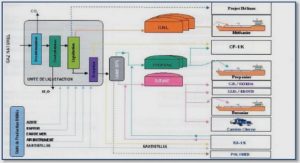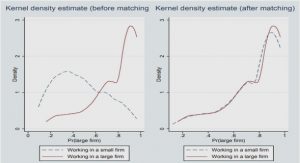Get Complete Project Material File(s) Now! »
Asparagine Deamidation in Triosephosphate Isomerase
In 1980, Gracy et al. detected asparagine deamidation in human TPI, on two dis-tinct asparagines with the sequence of LysMetAsn(15)GlyArg and ValThrAsn(71)GlyAla [30]. Their ndings explained previously observed heterogeneity of TPI in human cells [31, 32]. Further studies of this group showed that deamidation also occurs at Asn(15) and Asn(71) in other species of mammalian class [30].
Deamidation in mammalian TPI was shown to be an e ective initiator of protein degradation [33, 34]. Gracy et. al. proposed that, corruption of intermonomeric inter-actions caused by deamidation might explain TPI degradation [35]. This proposal relies on the interrelated actions occurring with respect to crucial location of two distinct deamidation sites in TPI. These interrelated actions might be summarized as follows in accordance with the chronological order of ndings of Gracy and coworkers.
Asn15 and Asn71 in mammalian TPI are located on loop1 and loop3 of each two monomers, returning four deamidation sites in total (Figure 1.5). Loop1 from monomer A and loop3 from monomer B (and viceversa) interdigidate in the interface of dimeric TPI, enabling Asn15 on monomerA (AsnA15) to interact with Asn71 on monomerB (AsnB71) (consequently AsnB15 to AsnA71, Figure 1.5).
Relative ratios of deamidation products (Asp71:Asp15) of TPI were found to be 2.54:1 and 1.73:1 for human and rabbit TPI respectively [30]. Relatively higher values of accumulated Asp71 with respect to Asp15 revealed the fact that Asn71 deamidates faster than Asn15. In addition to that, under alkaline conditions, in which mammalian TPI deamidates rapidly, deamidation was not observed in chicken TPI and yeast TPI which bear Asn15, however Asn71 is replaced by Lys and Ser, respectively [36]. Further analysis showed that Asn15 deamidation in chicken TPI only observed following the oxidation of Cys126 [36]. This fact exposed that in mammalian TPI, deamidation of Asn71 and Asn15 might occur in a sequential order, in a way that Asn15 deamidation is triggered by Asp71 [34, 36].
General Features of Quantum Mechanics (QM)
Quantum mechanics were developed to overcome the requirement for a di erent approach, rather than classical mechanics, in order to describe microscopic systems. The foundation of quantum mechanics relies on exploring approximate solutions to the Schrodinger equation to describe the electronic properties of the molecules. The Schrodinger equation H = E (3.19).
returns the system energy, E as an eigenvalue of the Hamiltonian operator, H . The typical form of the Hamiltonian operator consists of the kinetic and potential energy terms of the nuclei and the electrons: ~ 2 Xi 2 ~ 2 Xk 2 2me 2mk H = ri + rk + Vee + VeN + VNN (3.20).
where me is the mass of the electron, mk is the mass of the nuclei, ~ is the Planck’s constant divided by 2 , r is the Laplacian operator. When the system is de ned within Cartesian coordinates, the Laplacian has the form ri2 d2 d2 d2 dx2 dy2 dz2 = + + (3.21).
The potential energy terms; Vee , VeN , and VNN are the electron-electron repulsion, attraction of electron and nuclei, and nuclei-nuclei repulsion, respectively. All of these are applied classically. Accurate solutions of the Schrodinger equation can be obtained for small systems, however it is extremely di cult in the case of many-particle systems. This complexity is grounded on the fact that the motions of all of the particles are considered as correlated in the Schrodinger equation. Some approximations should be applied to remedy the complexity of the wave function. Under physical conditions, the nuclei of the molecule moves much more slowly than the electrons, since the mass of the nuclei is much more larger than the electrons. Considering this fact, Born-Oppenheimer approximation suggests that electronic energies can be computed for xed nuclear positions. That provides elimination of the attractive electron-nuclear potential energy term, taking the nuclear kinetic energy term independent of the electrons, and considering the nuclearnuclear potential energy term constant. So the Schrodinger equation with respect to this approximation is (Hel + VNN ) el = Eel el (3.22).
The eigenfunctions of Equation 3.22 are the molecular orbitals (MO) of the molecular system and they can be constructed as a linear combination of atomic orbitals (LCAO, [49]). Atomic orbitals are de ned by basis sets, usually with Gaussian functions.
ab initio Methods
Another complexity of the polyelectronic systems is due to the fact that the molecular orbitals mentioned in Section 3.3 are not provided as an input when the Schrodinger equation is attempted to be solved. The electronic structure calculations are done to obtain this variable. The variational theorem provides the route for these calculations, which states that the eigenvalue (energy) of an approximate wavefunction will always be higher than the eigenvalue of the true wavefunction. So that, starting from an estimated wavefunction, one should seek for the minimum value of energy at which the rst derivative of the electronic energy with respect to the molecular orbital is zero. To reach the point at minimum energy, an iterative process is applied which is known as the self-consistent eld (SCF) theory. SCF takes Coulomb and exchange integrals into account and uses Hartree-Fock (HF) equation: fixi = « ixi (3.23).
Atomic Charges Derived from Electron Density
There is no quantum mechanical operator to observe atomic charges of a molec-ular system, so that there is no unique de nition of the quantum charges. In order to assign charges on atoms, population analysis methods screen the electron density between nuclei [82]: Z qA = ZA A(r)dr (3.35).
where qA is the atomic charge, and ZA is the charge on nucleus for an atom A. The second term of the r.h.s of the Equation 3.35, integration over all electron density, is the total number of electrons in the system (N) and can be represented as:. AO X N = (PS) (3.36).
Continuum Solvation Models
In quantum mechanics, continuum solvation methods are used to represent solvent environment of molecular systems in order to obtain more accurate and realistic results for reactions which occur in solution phase. Solvation free energy of a system ( Gsol) is the summation of the electrostatic component ( Gelec), van der Waals interaction between the solute and solvent ( GvdW ), and the energy required to form a cavity within solvent ( Gcav) [82]. Gsol = Gelec + GvdW + Gcav (3.39) Gelec represents the polarization of the solvent and is modeled as a uniform medium with dielectric constant (« ). When the solute is brought from gas phase to solvent environment, the dipole introduced by solute in solvent cavity induces an electric eld within the cavity. The work required to create a charge distribution within the cavity can be de ned as the interaction between the solute charge density (r) and electrostatic potential (r) at a given point r in space. G = 2 Z (r) (r)@r (3.40).
Table of contents :
1. INTRODUCTION
1.1. Survey on Asparagine Deamidation
1.2. Essential Features of the Enzyme Triosephosphate Isomerase
1.3. Asparagine Deamidation in Triosephosphate Isomerase
1.3.1. Relevance of pKa in TPI deamidation
2. OBJECTIVE AND SCOPE
3. THEORETICAL BACKGROUND
3.1. Molecular Mechanics
3.1.1. The Force Field
3.2. Molecular Dynamics
3.3. General Features of Quantum Mechanics (QM)
3.4. ab initio Methods
3.5. Semiemprical Methods
3.6. Density Functional Theory
3.6.1. Basis Sets
3.6.2. Atomic Charges Derived from Electron Density
3.6.3. Continuum Solvation Models
3.7. Hybrid Methods : QM/MM
3.8. Sampling Methods: Umbrella Sampling
4. INITIATION OF THE REACTION OF DEAMIDATION IN TRIOSEPHOSPHATE ISOMERASE: INVESTIGATIONS BY MEANS OF MOLECULAR DYNAMICS SIMULATIONS
4.1. Abstract
4.2. Introduction
4.3. Computational Details
4.3.1. Preparation of the Samples
4.3.2. Molecular Dynamics Simulations.
4.3.3. Trajectory Analysis
4.4. Results and Discussion
4.4.1. Stability of the Trajectories
4.4.2. Solvent Accessibility.
4.4.2.1. Desolvation Eects on Residues Asn and Gly
4.4.2.2. Hydrogen Bond Analysis.
4.4.2.3. GlyH Interactions.
4.4.3. Near Attack Conformations (NAC)
4.5. Conclusions
5. WHY ASN71 DEAMIDATES FASTER THAN ASN15 IN THE ENZYME TRIOSE PHOSPHATE ISOMERASE? ANSWERS FROM s MOLECULAR DYNAMICS SIMULATIONS
5.1. Introduction
5.2. Computational Details
5.2.1. Preparation of the Samples
5.2.2. Molecular Dynamics Simulations
5.2.3. Quantum Mechanical Calculations
5.3. Results
5.3.1. Stability of the Simulations
5.3.2. Solvent Accessibility
5.3.3. Backbone Amide Acidity
5.3.3.1. Quantum Mechanical Calculations
5.3.3.2. Deviations of Backbone Amide Acidity in TPI
5.3.4. Near Attack Conformations (NAC’s)
5.3.5. Comprehensive Results
5.4. Discussions
5.4.1. Why Asn71 deamidates faster than Asn15 in mammalian TPI? .
5.4.2. Is Asp71 a prerequisite for Asn15 deamidation?
5.4.3. Tertiary structure eect
5.4.4. Primary structure eect
5.5. Conclusions
6. COMPARISON OF THE REACTION KINETICS OF ASPARAGINE DIPEPTIDE AND TRIOSEPHOSPHATE ISOMERASE USING QM/MM TOOLS WITH UMBRELLA SAMPLING TECHNIQUE
6.1. Introduction
6.2. Computational Details
6.2.1. QM Calculations
6.2.2. Preparation of the Systems Prior to QM/MM-MD Calculations
6.2.3. Umbrella Sampling Calculations
6.2.3.1. Benchmark Studies Prior to QM/MM Calculations
6.2.3.2. Constructions of the Reaction Coordinates
6.2.3.3. QM/MM-MD Calculations
6.3. Results
6.3.1. Reaction Mechanism
6.3.2. Benchmark Studies with Semiempirical Methods (QM-MD) .
6.3.3. Asparagine Dipeptide versus TPI: a QM/MM-MD study
6.3.3.1. Asparagine Dipeptide
6.3.3.2. TPI
6.4. Discusions
6.4.1. Why is the half-life time of small Asn peptide smaller than TPI?
6.4.2. The importance of Gly backbone amide acidity on the rate of deamidation
6.4.3. Why does Asn71 deamidate faster than Asn15?
6.5. Conclusions
7. TOWARDS ACCURATE AND EFFICIENT AMINOACID pKa PREDICTIONS USING CALCULATED ATOMIC CHARGES
7.1. Abstract
7.2. Introduction
7.3. Experimental Database
7.4. Computational Details
7.4.1. Quantum Mechanical Calculations
7.4.2. Molecular Dynamics Calculations
7.5. Results and Discussions
7.5.1. The Linearity of the Relationship Between Experimental pKa and Atomic Charges
7.5.2. Inuence of the Charge Model
7.5.3. Solvent Models
7.5.4. DFT Functional and Basis-set Benchmarks
7.5.5. Geometries and Stability
7.5.6. Conclusions
8. GENERAL CONCLUSION
APPENDIX A: SUPPORTING INFORMATION OF THE MOLECULAR DYNAMIC SIMULATION ANALYSIS
APPENDIX B: R2, MAD AND MAX-pKa OVER ALL OF THE TESTED METHODS OF THE TRAINING SET (ALCOHOLS)
APPENDIX C: R2, MAD AND MAX-pKa OVER ALL OF THE TESTED METHODS OF THE TRAINING SET (THIOLS)
REFERENCES





